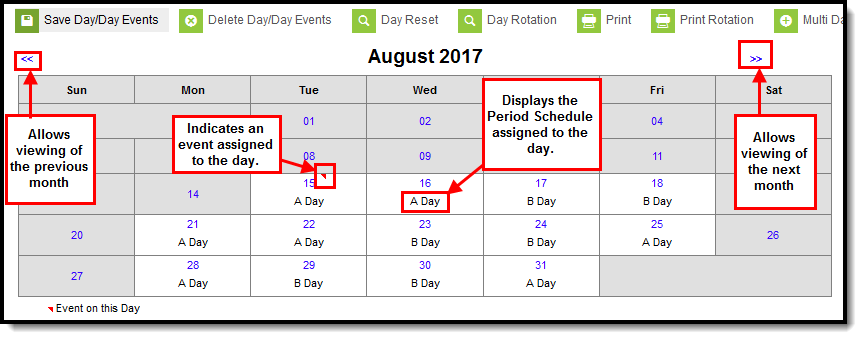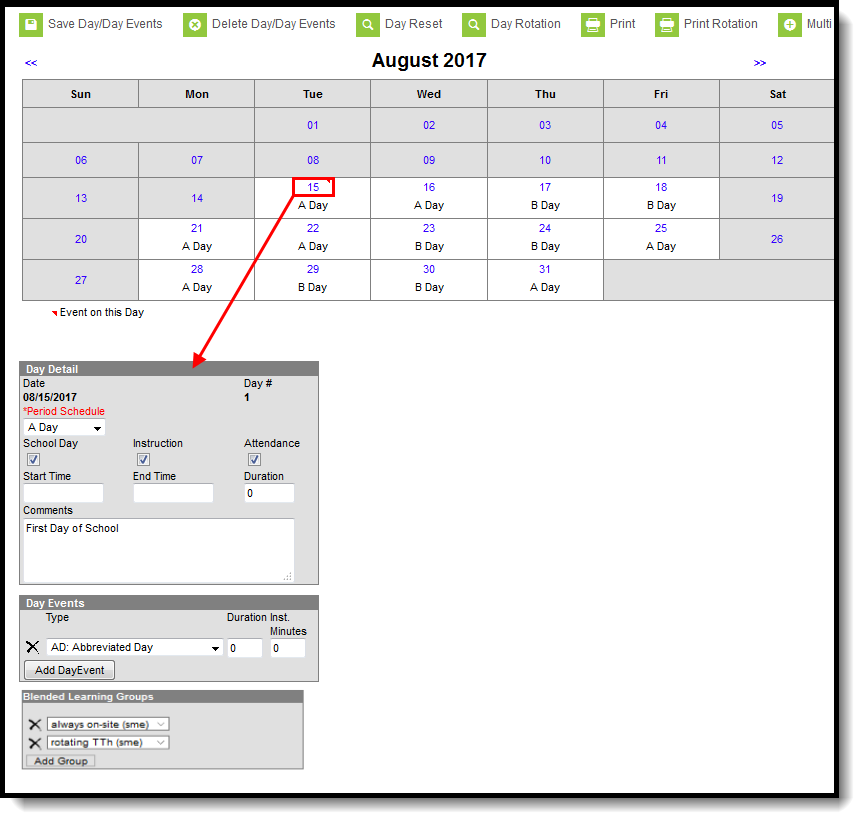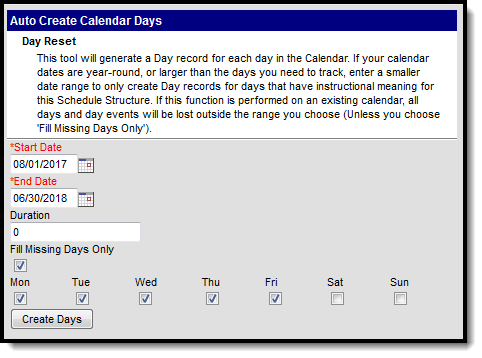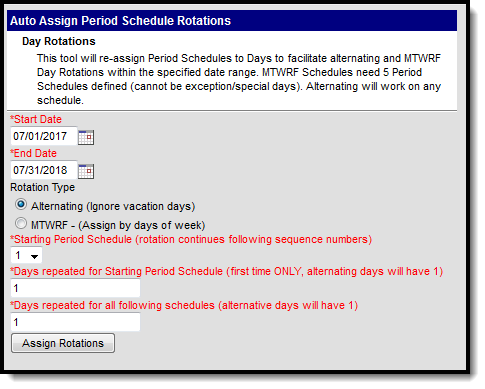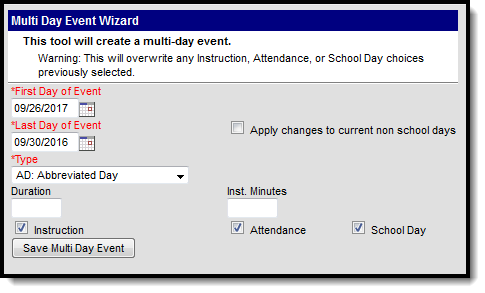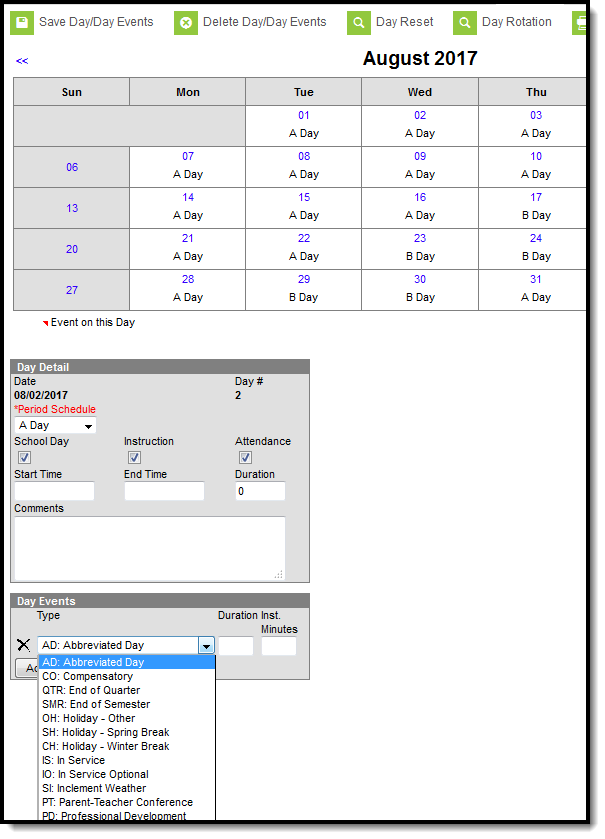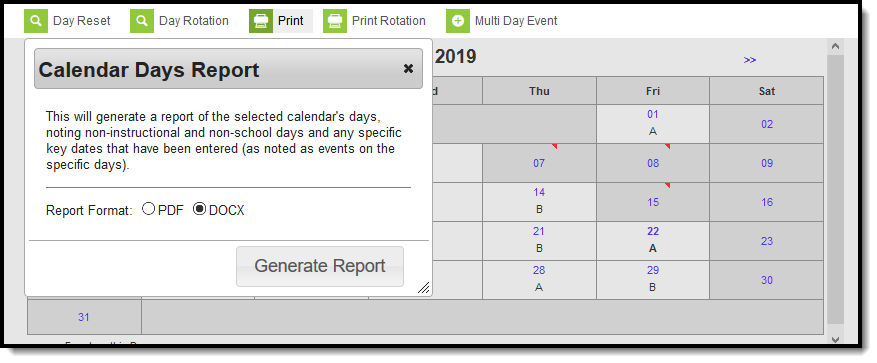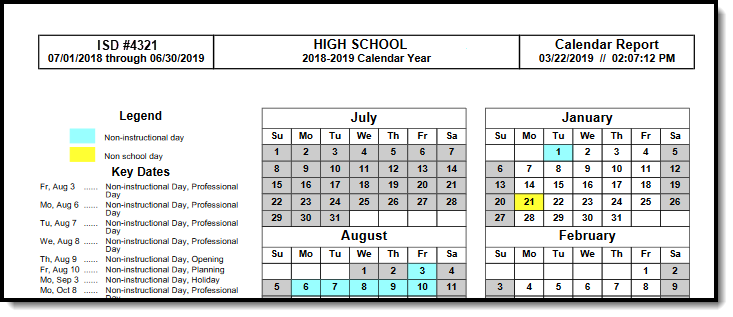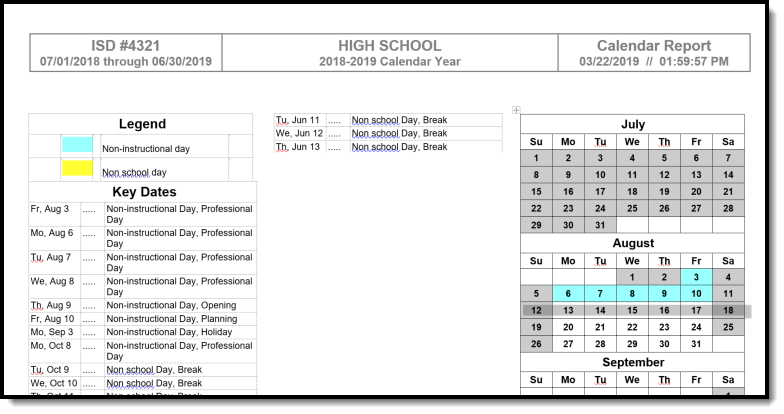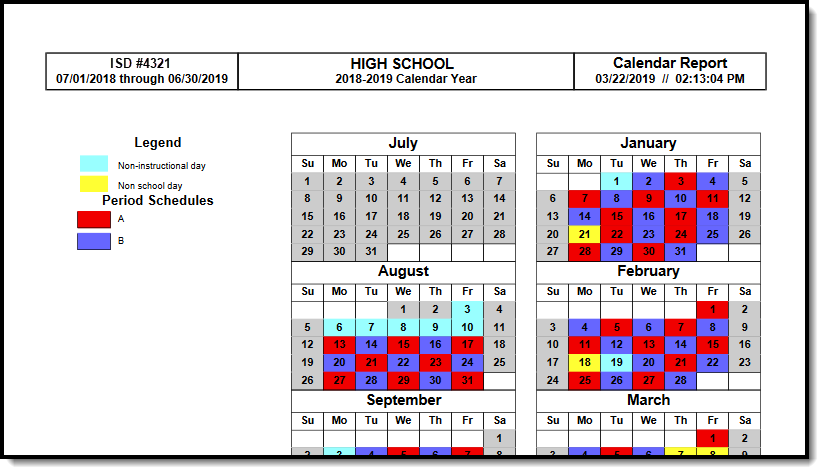Classic View: System Administration > Calendar > Calendar > Days
Search Terms: Days
The Days tool provides a calendar type of view for all of the days in the school calendar, determined by the year, school and calendar selected in the Campus toolbar. The Days tool also displays which Period Schedules are assigned to a particular day, whether any special events are assigned to a day, or whether a particular day is not recording attendance, is not an instruction day, or is not a school day.
Calendar View and Day Detail
The main view of the Days tool displays the start month and days of the calendar (again, determined by the selections in the Campus toolbar). When days have not been set (using the Day Reset or Day Rotation option), every day displays in gray. When days have been set, days that are outside of the calendar or are marked as a non-school day display in gray.
In the following image, days have been set using the Day Reset option, and period schedules have been assigned. The period schedule displays below the date of the day in the grid. This calendar begins on August 15. The red arrow above the date indicates an event is associated with this day, which can be viewed by selected the day to view the Day Detail. Period schedules have also been assigned to days. These schedules display on the calendar days without having to select a day to view the day detail.
Select any day to view any special events, schedules, comments, etc. for that day. The events, period schedules and selected day types display in the Day Detail editor.
The following table provides descriptions for the fields on the Day Detail editor.
| Field | Description |
|---|---|
| Date | Displays the date of the selected day. |
| Day # | Displays the number of instructional days that selected day is. For example, the first day of school has a day number of 1, the second day of school has a day number of 2. Only days marked as Instruction are assigned a number. When a non-instruction day is selected, the words Not an instructional day display instead. |
| Period Schedule | Indicates which period schedule is assigned to that day. Period schedules are assigned using the Day Rotation option; these can be assigned or changed manually as well by choosing a different period schedule from the dropdown list. This assignment displays below the date in the calendar grid. Additional logic determines when a period schedule is assigned. See the Day Rotation section for more information, and see the Periods article for more information on creating period schedules. |
| School Day | Indicates when the school is open and staff, students, administrators, etc. are on school grounds. This would be marked for a teacher in-service day, or for prep days before or after a term ends. See the Day Types section for more information. |
| Instruction | Indicates teachers are providing instruction to students, and causes the Day # field to calculate. See the Day Types section for more information. |
| Attendance | Indicates attendance entries for students are recorded. There are times when teachers are not able to take attendance when they should be taking attendance. One of the causes may be that this checkbox isn't marked. See the Day Types section for more information. |
| Start Time | Indicates the time the day begins. This is an optional field and only needs to be populated if the start time of the selected day varies from the standard start time of a school day. When a school starts late for the teacher's monthly staff meeting, enter the time the students were in the first period of the day, and add applicable comments for the change in start time. The entered time must be after or equal to the earliest start time entered for any period in the assigned period schedule. Values entered for this field prints on the Calendar Report and are considered shortened days. |
| End Time | Indicates the time the day ends. This is an optional field and only needs to be populated if the end time of the selected day varies from the standard start time of a school day. When a school ends early because of weather or another event, enter the time the last class of the day is released, and add applicable comments for the change in end time. The entered time must be before or equal to the latest end time entered for any period in the assigned period schedule. Values entered for this field prints on the Calendar Report and are considered shortened days. |
| Duration | Indicates the total length of the school day based on the entered start and end times. This is an optional field and only needs to be populated when the Start Time and End Time fields are also populated (it does not automatically calculate). For most days, this is left blank, as the instructional minutes, teacher day minutes, etc. are entered on the Calendar tool. |
| Comments | Provides more information on the reason for altered days or the change in start and end times. |
| Day Events | |
| Type | Indicates the reason for the event and cause the red arrow to display in the calendar grid. Types of days are created in the Attribute/Dictionary. Multiple events can be associated with a single day. It is recommended that whenever an event is added to a day, a Comment also be added that explains the reason for the event. Day events are filtered to appear under the appropriate calendar period structure. This means that day events only appear for the structure under which they were created. They also appear on the printed version of the Day Events report. |
| Duration | Indicates the length of the event. This value does not print on the Calendar Report and is used for state reporting purposes. |
| Instructional Minutes | Indicates how many total minutes students are receiving instruction as part of the event. In the case of inclement weather, a corresponding Event Type is selected, and the total instructional minutes for the weather day are added here. When the school closes at lunch time (no instruction in the afternoon), this field is populated with a value that totals the start of day to the lunch period (240 minutes, for example). The sum of Instructional Minutes entered on Day Events is counted as non-instructional minutes and is subtracted from the overall instructional day. The remaining time (calculated by subtracting the instructional minutes on the day event from the Student Day minutes on the calendar) is counted as non-instructional minutes. |
Grade Level (Nebraska Only) | For Nebraska Only: Identifies the grade level in which the calendar is associated. Grade levels send to Ed-Fi as their own calendar and Day Events are added per grade to update the data in the ODS for the grade level calendar only. |
| Blended Learning Groups | |
| Blended Learning Groups allow districts to create student groups to manage classes and attendance for students in a setting for students who are on-site in a building for learning, for students who are virtually attending classes or a combination of both. Once Blended Learning Groups are created, those groups can be assigned to Calendar Days and are included on the Calendar Day Rotation Report. See the Blended Learning Groups section below for more information. | |
Day Types
Each day of the school year needs to be marked for School, Instruction and Attendance, or some combination of each. After using the Day Reset option, all of these options are marked for each day, which means users need to modify the ones that should not be marked this way.
Also noted in the table above, here are the definitions for these fields.
- School Day - this option is marked when teachers, students, administrators, etc. are on school grounds.
- Instruction - this option is marked when students are on school grounds and attending classes.
- Attendance - this option is marked when attendance entries are recorded.
Below are some examples of when these fields should be marked.
The examples shown below vary by district. Please refer to your district's policies and procedures for the proper Day Types used for your district.
| Example | School Day | Instruction | Attendance | Comments |
|---|---|---|---|---|
| Regular School Day | X | X | X | On a regular school day that is scheduled for the normal amount of time, the school is open, teachers are providing instruction and attendance is being recorded. |
| Responsive School Day | X | X | X | When providing responsive course options (flex scheduling, intervention sessions, etc.), this is treated as a regular day, just the available course offerings would be altered. See the Responsive Scheduling article for more information. |
| In Service Day | X | Teachers and other administrative staff are on campus, completing grades and entering scores, or prepping for upcoming terms. Students are not being taught and attendance is not being recorded. | ||
| Total Weather Day | When weather causes a total day off, no options are marked. | |||
| Late Start | X | X | X | This is treated as a regular school day. A Day Event should be added and the start/end time fields need to be populated to indicate a shortened day happened. |
| Early Release | X | X | X | This is treated as a regular school day. A Day Event should be added and the start/end time fields need to be populated to indicate a shortened day happened. |
| Holiday | During extended times off for break (winter, spring, etc.), no options are marked. | |||
| Professional Development - All Day | X | When teachers and staff are attending special conferences or meetings for the entire day, only mark the School Day checkbox. | ||
| Professional Development - Partial Day | X | X | X | When teachers and staff are attending special conferences or meetings for part of the day, all options are marked. A Day Event, Comments and Start/End Times need to be entered. |
| Non-Attendance Days | X | X | There may be reasons determined by the state department of education or the district office that attendance doesn't need to be recorded for certain days, even though students are being instructed. In this instance, only mark the School and Instruction checkboxes. |
Day Reset
A Day Reset is required at the start of the school year, and creates the calendar days. This action updates the days in the calendar to allow attendance to be recorded, for enrollment tallies to count, for membership and attendance reports to calculate properly, etc. On a newly created calendar, before the Day Reset is done, the calendar displays all days in gray; after the Day Reset is done, days within the date range of the calendar in white, unless it has been modified to not be a school day.
Set Calendar Days for a New School Year
Follow these steps to create calendar days before the school year begins.
This process marks all days within the date range for Instructional, School and Attendance. Users need to manually mark the exceptions for holidays and other events at a later time.
- Select the Day Reset icon. An Auto-Create Calendar Days editor appears.
- Enter the dates of the calendar to build a record for each day in this schedule structure. The Start Date is the first day of instruction (when students are attending classes). The End Date is the last day of instruction.
- Enter a Duration amount. This is considered an override value and should only be populated when the minutes for a regular school day are different than the value of minutes entered on the Calendar Info tool.
- Remove the selection for Fill Missing Days Only.
- Mark the days of the week for which to create days.
- Click the Create Days button. This process may take a few moments. When it is finished, calendar days are created.
Set Calendar Days to Address a Weather Day
Follow these steps to change the current calendars days due to a weather day that causes the need to add additional days at the end of the school year.
- Select the Day Reset icon. An Auto-Create Calendar Days editor appears.
- Enter the dates of the calendar to build a record for each day in this schedule structure. For example, three days were added to the end of the calendar, which moved the last day of school from June 6 to June 9, the Start Date is entered as June 7, and the end date is entered as June 9.
- Enter a Duration amount. This is considered an override value and should only be populated when the minutes for a regular school day are different than the value of minutes entered on the Calendar Info tool.
- Mark the Fill Missing Days Only option. This option preserves existing days and day events that happened previously in the school year.
- Mark the days of the week for which to create days.
- Click the Create Days button. This process may take a few moments. When it is finished, calendar days are created.
Day Rotations
When the calendar has multiple rotations (A/B days. etc.), use the Day Rotation option to assign a period schedule to school days. This icon only appears when multiple Period Structures are created.
Modifying day rotation for a calendar after the entered start date of the calendar or for past calendars can cause permanent data loss of attendance information and responsive scheduling offerings. Day Rotations should only be performed prior to the beginning of the calendar or when a day needs to be changed from a school day to a non-school day, or a school day with one period schedule to a school day of another period schedule.
Period schedules marked as Exception/Special Day (see the Periods article for more information) are not included when using the Day Rotation option. This period structure needs to be assigned manually. Additionally, any day that is currently assigned to a period schedule marked as an Exception/Special Day is excluded from the Day Rotation process and needs to be updated manually.
Days must be created (using the Day Reset option) before period schedules can be assigned and a rotation established.
Set Rotation Days
- Select the Day Rotation icon.
- Enter the Start Date and End Date of the rotation schedule. This is usually the length of the school year. The date range of the calendar populates these days already; when day rotation only needs to be set for a month or some date range less than the total calendar, enter those dates accordingly.
- Select the Rotation Type. Options are Alternating or MTWRF.
- When using the Alternating option, days are marked as Monday - A Day, Tuesday B Day, etc. Non-instruction days are ignored.
- When using the MTWRF option, days are assigned by the day of the week. Five period schedules need to be created for this option to be available.
- Enter the Starting Period Schedule. This is the schedule that is used on the first day.
- Enter how many days the rotation is used in the Days Repeated for Starting Period Schedule field. For example, there are three (3) different rotation days, and two (2) days of each rotation occur before the rotation moves to the next schedule (Monday - A day, Tuesday - A day, Wednesday - B day, Thursday - B day, etc.).
- Enter how many days the rotation repeats for all following schedules in the Days Repeated for all following schedules field. This follows the same logic as step 5. In the same example above, this field would be populated with a value of 2.
- Click the Assign Rotation button. Rotations of the period schedules are now available in the calendar. The assigned period schedule displays when viewing the Days tool (see first image on this article).
A warning message displays when Day Rotations are modified for the current or past calendars, as attendance data, responsive scheduling days and blended learning assignments may be deleted and cannot be recovered.
Weather Days
When a school day needs to be changed to a non-school day in the middle of the year, the days must be updated to reflect the now non-school, non-instructional day.
- When the skipped day affects the day rotation, use the Day Rotation option. When the weather day was Monday, an A day, Tuesday becomes the A day. This also changes the following days in the calendar to a new rotation.
- When additional days need to be added to the end of the calendar, use the Day Reset option to modify the days not marked as a school/instruction day.
- When days do not need to be added at the end of the calendar and the calendar does not have a day rotation, but the day still needs to be changed to a non-school/non-instruction day, use the Day Reset option.
Change the Day Rotation
When the Day Rotation needs to be reset due to a rescheduling or an unexpected day off, use the Day Rotation option. This does not overwrite day events or adjust previous days. It only affects the date range that is entered. For example, for a weather day that occurs in January, the administrator would modify that day as a non-instruction day, and then use the Day Reset option for the remainder of the year to reset the days to the appropriate schedule.
To change the assigned period schedule on just one day, manually modify that selection in the Day Detail editor.
Permissions to reset calendar days can only be given to an individual's user account. They cannot be inherited from an administrator's user group that has every tool right assigned.
Multi-Day Events
The Multi-Day Events option allows schools to mass-assign an event or type of school day to a consecutive range of dates. This allows a school to input the same event in a date range (consecutive days) at one time instead of entering the event several times.
Use this option to enter dates for Winter Break or Testing Days.
Use the Multi-Day Event Wizard
- Enter the date of the First Day of the Event in mmddyy format or click the calendar icon to select a date.
- Enter the date of the Last Day of the Event in mmddyy format or click the calendar icon to select a date.
- Select the Type of day from the dropdown list.
- Enter the Duration of the school day, and the length of Instruction in minute format.
- Mark the days for Instruction, Attendance and/or School Day.
- Click the Save Multi-Day Event button. The screen refreshes to show the calendar grid with the newly entered events.
Manually Modify a Specific Day
To modify a single day in the calendar, for start time or for a special event (like testing days, etc.),
- Select that date from the calendar. A Day Detail editor displays.
- Verify the Period Schedule (when multiple period schedule exists) is correct. Modify as needed.
- Verify the correct School Day, Instruction and Attendance checkboxes are marked. Modify as needed.
- Enter a Start Time and End Time when the event for this day modifies the regular school day start and end times.
- Enter the Duration of the day in minutes. This value, along with the entered start and end times, acts as an override to the minutes entered on the Calendar Info tool (minutes for a standard day).
- Enter any Comments necessary.
- Select a Day Event Type from the dropdown list, if necessary. Enter the Duration and Instructional Minutes here as well.
- Click the Save Day/Day Events icon when finished.
Blended Learning Groups
Blended Learning Groups are created to manage the number of students in a school building at any given time, in an effort to provide on-site learning, virtual learning, or a combination of on-site and virtual learning.
See the Blended Learning Groups article for an overview of the entire Blended Learning Group process.
Multiple learning groups can be assigned to a single day. Students who are expected to be Virtual show an indication of this status when they are assigned to a group that is associated to this calendar day. Groups that are attending physically should not be linked to the calendar days.
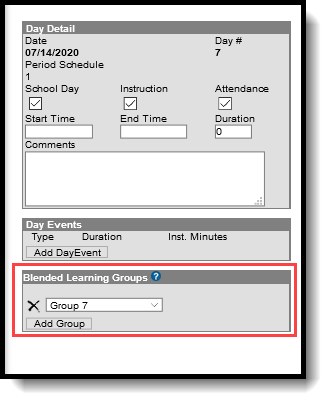 Blended Learning Groups Editor
Blended Learning Groups Editor
Manually Assign Blended Learning Groups to Calendar Days
- Select the desired Day from the selected Calendar month.
- In the Blended Learning Groups editor, click the Add Group button.
- Select the desired groups from the dropdown list.
- Repeat this process until all days have a group assigned.
Blended Learning Groups can be assigned for current and future days, as well as days in the past. When assigning groups to days in the past, participation records are created for all students assigned to the selected group, which cannot be undone.
Print Calendar Days
Calendar days can be printed using either the Print icon or the Print Rotation icon. These reports print in either PDF or DOCX format.
- The Print icon generates the selected calendar's days, noting non-instructional and non-school days and any specific key dates that have been entered (as noted as events on the specific days).
- The Print Rotation generates the selected calendar's days, noting the different period schedules that have been assigned to the days. Blended Learning Groups are included on this report.
The Total Instructional, Total Non-Instructional, Total Non-School values are calculated using the value entered in the Student Day field on the Calendar tool, instead of the Instructional minutes in the Period tool.
Calendar Days Report
The Calendar Report generated from the Print icon lists non-instructional days and non-school days, and a list of day events that were added to specific days.
When no Instructional Minutes are set on the Days editor, Minutes reported result in the subtraction of Student Day minutes (System Administration > Calendar > Calendar > Student Day (instructional minutes) from Instructional Minute calculations. Non-instructional minute calculations are impacted.
Calculation of Total Minutes
At the bottom of the Calendar Days Report, there is a total number of Days and Minutes sorted by Total Instructional, Total Non-Instructional and Total Non-School. The calculation for each begins with the entered School Day minutes on the Calendar and uses the School Day, Instruction and Attendance checkboxes on the Day Event editor to determine how many minutes of instruction time, non-instructional time and non-school days (includes weekends) are included in the calendar.
| Item | Calculation |
|---|---|
| Total Instruction Minutes | The sum of all days from the start of the calendar to the end of the calendar that are marked as School Day and Instruction Day, multiplied by the School Day value value entered on the Calendar tool. In the image above:
When there are 171 school days and the School Day value is 385, the total minutes is 65,835 (171 x 385). |
| Total Non-Instruction Minutes | The sum of all days in the calendar that are not marked as Instruction, but is still a School Day, multiplied by the School Day value entered on the Calendar tool. In the image above:
When there are 3 days not marked as Instruction and the School Day value is 385, the total Non-Instructional minutes is 1,155 (3 x 385). Non-Instruction minutes are also tallied when a Day Event has an Instruction Minutes value entered. For a Day Event (Shortened Day, for example) that is 185 minutes, that number is subtracted from the Student Day minutes (385), giving a value of 185 non-instructional minutes and 200 instruction minutes. |
| Total Non-School Minutes | The sum of all days, including weekends, where the School Day checkbox is not marked, multiplied by the School Day value entered on the Calendar tool. In the image above:
When there are 191 non-school days and the School Day value is 385, the total Non-School minutes is 73,535 (191 x 385). |
Using the same list of Day Events, this table provides additional information on how the Total Minutes values are calculated
| Example | School Day | Instruction | Attendance | Total Minutes |
|---|---|---|---|---|
| Regular School Day | X | X | X | Counts as a full day of instruction. |
| Responsive School Day | X | X | X | Counts as a full day of instruction. |
| Inservice Day | X | Counts as a full day of non-instruction time. | ||
| Total Weather Day | Counts as a full non-school day. | |||
| Late Start | X | X | X | Counts as a day of instruction, but requires the time fields and the Instruction Minutes field to be populated for accurate calculations. |
| Early Release | X | X | X | Counts as a day of instruction, but requires the time fields and the Instruction Minutes field to be populated for accurate calculations. |
| Holiday | Counts as a non-school day. | |||
| Professional Development - All Day | X | Counts as a full day of non-instruction time. | ||
| Professional Development - Partial Day | X | X | X | Counts as a day of instruction, but requires the time fields and the Instruction Minutes field to be populated for accurate calculations. |
| Non-Attendance Days | X | X | Counts as a full day of instruction. |
Calendar Rotation Days Report
The Calendar Report generated from the Print Rotation icon lists non-instructional days and non-school days, and the period schedules assigned to each school day, as well as assigned Blended Learning Groups when they have been assigned.
 Blended Learning Groups on Print Rotation Report
Blended Learning Groups on Print Rotation Report
Date Validations
The following logic is used to ensure proper dates are entered.
- Day Reset does not run when the entered dates fall outside of the calendar start and end dates.
- The Days tool displays error messages when there are no term schedules defined or when any term schedules are missing dates. It also displays an error message when there are no period schedules defined.
- Term dates are required in order to run the Day Reset wizard.
Deleting any school day in which a student has an attendance record causes a record of the attendance data deleted to be recorded in the Audit Attendance table.
When no Instructional Minutes are set on the Days editor, Minutes reported results in the subtraction of Student Day minutes (System Administration > Calendar > Calendar > Student Day (instructional minutes) from Instructional Minute calculations. Non-instructional minute calculations are also impacted.
Responsive Scheduling and Calendar Days
This section covers step 4 in the Responsive Scheduling Workflow.
Following the best practice of creating a separate period schedule for Responsive Scheduling, that period schedule is assigned to a day the same way as any other period schedule. Use the procedures detailed above for assigning a particular schedule to a calendar day.
Responsive sessions can only be assigned for days marked as Instruction.
When an assigned period schedule needs to be modified (due to snow day or other issue), any offerings that have been created for a responsive day are deleted, and any students who have been scheduled for those offerings are unscheduled.

